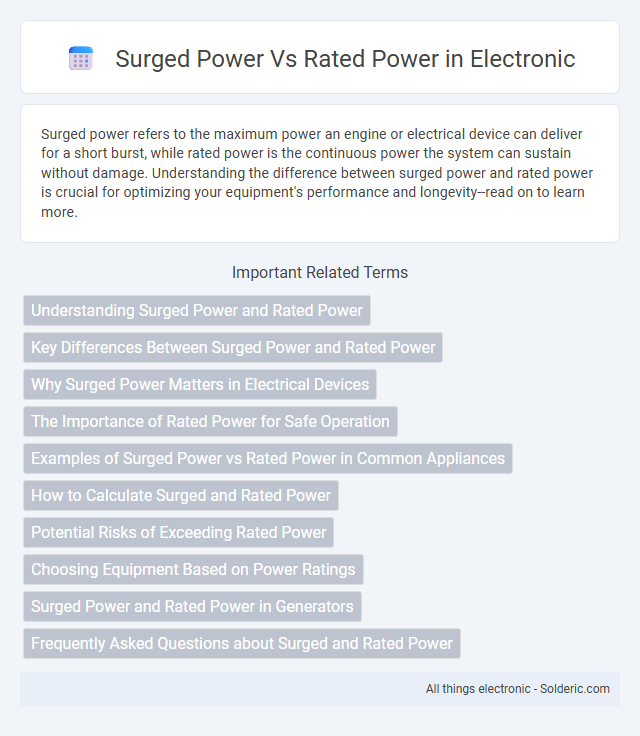Surged power refers to the maximum power an engine or electrical device can deliver for a short burst, while rated power is the continuous power the system can sustain without damage. Understanding the difference between surged power and rated power is crucial for optimizing your equipment's performance and longevity--read on to learn more.
Comparison Table
| Aspect | Surged Power | Rated Power |
|---|---|---|
| Definition | Maximum temporary power output beyond rated capacity | Continuous power output the device or engine can sustain |
| Duration | Short term, often seconds to minutes | Long term, steady operation |
| Application | Handling sudden loads or startup conditions | Normal operating condition for optimum efficiency |
| Impact on Equipment | Can cause increased wear or stress if sustained | Designed for safe, reliable operation |
| Measurement | Peak power output measured in horsepower (HP) or kilowatts (kW) | Continuous power output in horsepower (HP) or kilowatts (kW) |
Understanding Surged Power and Rated Power
Surged power refers to the maximum short-term power a device, such as an electric motor or an engine, can handle during peak load conditions, often lasting just a few seconds. Rated power is the continuous power level that the device can sustain safely and efficiently without damage or overheating. Understanding the difference between surged power and rated power helps you select equipment that meets both instantaneous performance needs and long-term reliability.
Key Differences Between Surged Power and Rated Power
Surged power refers to the maximum power output an engine or generator can deliver for a short duration without damage, often exceeding its normal operating capacity. Rated power is the continuous power level an engine or generator is designed to sustain safely during regular operation. The key difference lies in surged power's temporary peak capability versus rated power's stable, long-term performance limit.
Why Surged Power Matters in Electrical Devices
Surged power represents the maximum instantaneous power an electrical device can handle without damage, often exceeding its rated power during startup or sudden voltage spikes. Understanding surged power is crucial because it ensures your device can withstand these brief overloads, preventing premature failure and maintaining operational integrity. Properly accounting for surged power safeguards your investment and enhances device reliability in real-world electrical conditions.
The Importance of Rated Power for Safe Operation
Rated power defines the maximum continuous power a device or system can handle safely without damage, ensuring reliable operation under normal conditions. Surged power refers to short bursts of higher power that exceed rated levels but must remain within limits to prevent overheating or component failure. Understanding your equipment's rated power is crucial for avoiding risks associated with power surges and maintaining long-term safety.
Examples of Surged Power vs Rated Power in Common Appliances
Surged power refers to the initial power draw when an appliance starts, which is often significantly higher than its rated power, the continuous power it consumes during regular operation. For example, a refrigerator with a rated power of 150 watts may have a surged power of 600 watts due to the compressor motor starting up. Similarly, an air conditioner rated at 1200 watts can experience a surge power of up to 3500 watts when the compressor kicks in, while a microwave oven typically shows a rated power of 1000 watts but surges up to 1500 watts when heating elements activate.
How to Calculate Surged and Rated Power
Surged power is calculated by multiplying the rated power by the surge factor, which accounts for the temporary increase in load capacity, often ranging from 1.5 to 2 times the rated power depending on the equipment type. Rated power refers to the nominal power output specified by manufacturers, typically expressed in watts or horsepower, and is determined through standardized testing under normal operating conditions. Accurate calculation of surged power involves understanding both the equipment's rated power and the specific surge factor based on operational demands or industry standards.
Potential Risks of Exceeding Rated Power
Exceeding rated power through surged power can lead to significant risks such as overheating, reduced lifespan, and catastrophic failure of electrical equipment. The insulation materials and components are often designed to withstand only the rated power, making surges capable of causing irreversible damage. Consistently operating beyond rated power also increases the likelihood of fire hazards and increased maintenance costs due to accelerated wear and tear.
Choosing Equipment Based on Power Ratings
Selecting equipment based on power ratings requires understanding the difference between surged power and rated power to prevent damage and ensure performance. Surged power represents the maximum instantaneous power a device can handle during startup or transient events, while rated power indicates the continuous power capacity under normal operating conditions. Choosing equipment with surged power ratings that exceed expected startup loads and rated power suitable for steady-state operation ensures reliability and longevity in electrical and mechanical systems.
Surged Power and Rated Power in Generators
Surged power in generators refers to the maximum power output a generator can deliver for a short duration without damage, often exceeding its rated power capacity. Rated power is the continuous, steady-state power output a generator is designed to sustain under normal operating conditions. Understanding the difference ensures you select a generator that meets both your peak power demands and long-term energy needs efficiently.
Frequently Asked Questions about Surged and Rated Power
Surged power refers to the maximum power an engine or motor can produce for a short duration without damage, typically higher than its rated power, which is the continuous power it can sustain safely. Frequently asked questions often address the difference in application, with surged power being crucial for starting heavy loads or short bursts of high demand, while rated power ensures long-term reliability and efficiency. Understanding the distinction helps in selecting appropriate equipment for specific tasks, balancing performance requirements with durability.
Surged power vs Rated power Infographic

 solderic.com
solderic.com